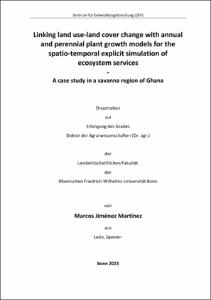Linking land use-land cover change with annual and perennial plant growth models for the spatio-temporal explicit simulation of ecosystem servicesA case study in a savanna region of Ghana

Linking land use-land cover change with annual and perennial plant growth models for the spatio-temporal explicit simulation of ecosystem services
A case study in a savanna region of Ghana

| dc.contributor.advisor | Fürst, Christine | |
| dc.contributor.author | Jiménez Martínez, Marcos | |
| dc.date.accessioned | 2023-08-30T13:04:55Z | |
| dc.date.available | 2023-08-30T13:04:55Z | |
| dc.date.issued | 30.08.2023 | |
| dc.identifier.uri | https://hdl.handle.net/20.500.11811/11018 | |
| dc.description.abstract | Many West African economies have been experiencing fast growth over recent decades. At the same time, their landscapes are also experiencing one of the fastest changes in the world, and the pace has accelerated over recent decades. These changes are driven both by local demands and the historical export of renewable resources. The need to satisfy the growing internal food demand has driven widespread and uncontrolled cropland expansion, whereas global concerns regarding the need to transition towards a new techno-economic paradigm based on the substitution of fossil fuels with biomass products, put additional pressures on local land use systems derived from the global competition for land. In this context, there are clear signs that many West African landscapes are experiencing a degradation of their capacities to reproduce biomass. Therefore, regional land use planning is of foremost importance to improve the satisfaction of human nutritional requirements and energy demand in the medium-term and ensure it in the long term. Land use planning processes involve an exercise of anticipating the impact that a chosen strategy may have on the achievement of certain goals. Because the future is uncertain, robust land use planning processes must explore different development pathways and rely on new simulated data.
The purpose of this study is to explore how available data and one-dimensional plant growth models can be used in a spatially-explicit modeling environment to represent medium-/long-term temporal dynamics of the match between ecosystem services supply (using biomass provision as an example), and demand on a district scale. Benefits derived from the consumption of biomass have been quantified in terms of nutritional, feed and fuel yields. The prospective trends of these indicators have been simulated in a spatio-temporally explicit way under three alternative land use change pathways, in combination with different paces of technology adoption change and three projections of population growth. The methodology has been applied over a land use-land cover (LULC) map of high grain and thematic resolution covering the districts of Bolgatanga Municipal and Bongo in the interior savanna zone of Ghana. Land use transitions have been simulated within the GISCAME platform, which allows simulation of future LULC scenarios using data for which no temporal series is available. Agricultural biomass production data has been simulated on the plot-scale with the process-based crop modeling platform APSIM to analyze the production trade-offs among different cropping choices, involving groundnut, millet, sorghum, maize, rice. Additionally, woody biomass growth data has been simulated at the stand-level by fitting a logistic curve to data selected after an extensive literature review. The results show that the availability of micronutrients (iron and zinc) provided by regional agriculture shall be sufficient to satisfy the dietary requirements of the whole population, but the provision of calories is insufficient. Croplands are the land use types that provide the largest amounts of food and also fuel biomass. Therefore, scenarios with more widespread cropland expansion perform better in all of the indicators assessed. The main shortcoming of the methodology applied to inform real land use planning processes is that the spatio-temporal simulation of regulating ecosystems services was not considered. Therefore, the contribution of non-cultivated land use classes to the renewability of biomass production was not fully accounted for. Model and simulation of a wider range of land use and biomass types in spatially-explicit models would also contribute to significantly increasing the value of these studies to support land use decisions and inform better policies. Improvements across the whole chain are required to increase the efficiency in which biomass production and harvesting satisfies human demands. Integration of spatially-explicit biomass production assessments with models relevant to value chain development, such as transportation costs, could contribute to reducing the socio-ecological risks associated with socio-economic transitions. | en |
| dc.language.iso | eng | |
| dc.rights | In Copyright | |
| dc.rights.uri | http://rightsstatements.org/vocab/InC/1.0/ | |
| dc.subject | Landnutzungsänderung | |
| dc.subject | Biomasse | |
| dc.subject | Savanne | |
| dc.subject | Ernährungssicherheit | |
| dc.subject | Energieversorgungssicherheit | |
| dc.subject | Erntemodellierung | |
| dc.subject | land use change | |
| dc.subject | biomass | |
| dc.subject | savanna | |
| dc.subject | nutrition security | |
| dc.subject | energy security | |
| dc.subject | crop modeling | |
| dc.subject.ddc | 550 Geowissenschaften | |
| dc.subject.ddc | 630 Landwirtschaft, Veterinärmedizin | |
| dc.title | Linking land use-land cover change with annual and perennial plant growth models for the spatio-temporal explicit simulation of ecosystem services | |
| dc.title.alternative | A case study in a savanna region of Ghana | |
| dc.type | Dissertation oder Habilitation | |
| dc.publisher.name | Universitäts- und Landesbibliothek Bonn | |
| dc.publisher.location | Bonn | |
| dc.rights.accessRights | openAccess | |
| dc.identifier.urn | https://nbn-resolving.org/urn:nbn:de:hbz:5-71882 | |
| ulbbn.pubtype | Erstveröffentlichung | |
| ulbbnediss.affiliation.name | Rheinische Friedrich-Wilhelms-Universität Bonn | |
| ulbbnediss.affiliation.location | Bonn | |
| ulbbnediss.thesis.level | Dissertation | |
| ulbbnediss.dissID | 7188 | |
| ulbbnediss.date.accepted | 24.08.2022 | |
| ulbbnediss.institute | Zentrale wissenschaftliche Einrichtungen : Zentrum für Entwicklungsforschung (ZEF) | |
| ulbbnediss.fakultaet | Landwirtschaftliche Fakultät | |
| dc.contributor.coReferee | Borgemeister, Christian | |
| ulbbnediss.contributor.orcid | https://orcid.org/0000-0002-7775-6434 |
Dateien zu dieser Ressource
Das Dokument erscheint in:
-
E-Dissertationen (1013)




